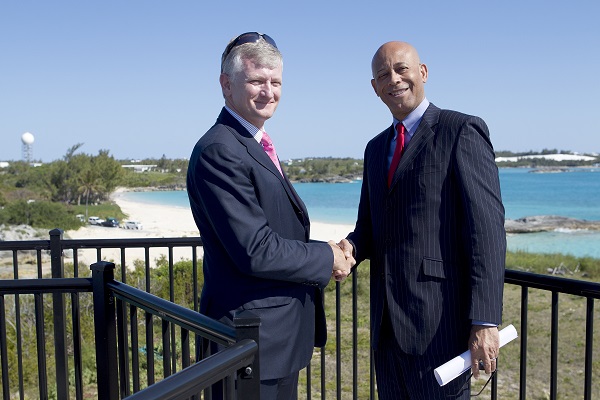New Wildlife Viewing Tower For Cooper’s Island
The base of the main radar tower of the former NASA Tracking Station has been refurbished the radar base as a wildlife watch tower, Minister of Environment and Planning Sylvan Richards said.
“Built in 1960 the radar tower was part of an 8,000 square foot building that was used to track spacecraft during the Gemini, Apollo and Skylab missions,” said the Minister.
Minister Richards and HSBC CEO Richard Moseley overlooking the top of the Wildlife Watchtower:
Minister Richards continued, “In 2011, during the demolition of the Radar building, the tower was found to be hollow with maintenance access, railings on the upper deck and a tremendous view of Nonsuch Island, the Castle islands, the south shore reefs and the beaches of Cooper’s Island.
“With sponsorship from HSBC Ltd, Baron Construction Ltd. refurbished the radar base as a ‘wildlife watch tower’ complete with a spiral staircase, new railings and a series of display boards which describe the rare flora and fauna of the reserve, as well as the history and restoration of the reserve.
“Today the newly refurbished tower no longer serves to guard against enemy ships or to track space craft, but to allow the public to experience, up close, the annual migration of the Humpback whale, the Bermuda Petrel and the Longtail. I think we can all agree that even without the wildlife, the view is breathtaking!”
Minister Richards’ full statement follows below:
Good Morning,
Thank you all for coming out to the beautiful Cooper’s Island Nature Reserve today.
Sitting at the south eastern tip of Bermuda, Cooper’s Island, combined with the adjacent Nonsuch Island and Castle Island Nature Reserves, make up almost 100 acres of the most pristine habitats Bermuda has to offer.
They are home to the largest populations of the island’s most threatened species including the Bermuda Petrel, White-tailed Tropic Bird, Bermuda Skink, Hermit Crab and Killifish.
Totaling 43 acres, Cooper’s Island Nature Reserve forms the backbone of this natural sanctuary and is recognized as an Internationally Important Bird Area by the National Audubon Society.
In 2008, after more than 40 years of use as a U.S. NASA Tracking Station, Cooper’s Island was given back to the Government of Bermuda and protected as a nature reserve.
Since 2010 HSBC Ltd has actively supported the restoration of Cooper’s Island Nature Reserve. Since then, under the direction of the government’s Department of Conservation Services, HSBC Bermuda and its dynamic volunteers have been restoring the southernmost section of the reserve, guided by the Cooper’s Island Nature Reserve Management Plan 2008.
In 2012, this work culminated in the handover of 1.5 acres of the most heavily developed section of the reserve back to Bermuda as a natural preserve for wildlife. Work included the demolition of large derelict buildings and storage bunkers, removal of defunct utilities and roads as well as the culling of thousands of invasive species. This was followed by the installation of Longtail “igloos” which are prefabricated housing for these crevice dwelling birds, and the planting of over 2000 native and endemic plants.
Today, the only structure remaining is the iconic base of the main radar tower of the former NASA Tracking Station, which you see behind me today.
Strategically located on the most southerly tip of the island and in the approximate location of ‘Fort Pembroke’, which was one of the original forts that defended Bermuda, the radar tower had an almost 360 degree unobstructed view of the Atlantic. Built in 1960 the radar tower was part of an 8,000 square foot building that was used to track spacecraft during the Gemini, Apollo and Skylab missions.
In 2011, during the demolition of the Radar building, the tower was found to be hollow with maintenance access, railings on the upper deck and a tremendous view of Nonsuch Island, the Castle islands, the south shore reefs and the beaches of Cooper’s Island.
With sponsorship from HSBC Ltd, Baron Construction Ltd. refurbished the radar base as a “wildlife watch tower” complete with a spiral staircase, new railings and a series of display boards which describe the rare flora and fauna of the reserve, as well as the history and restoration of the reserve.
Today the newly refurbished tower no longer serves to guard against enemy ships or to track space craft, but to allow the public to experience, up close, the annual migration of the Humpback whale, the Bermuda Petrel and the Longtail. I think we can all agree that even without the wildlife, the view is breathtaking!
Strategically this area is very important. It has no development and no artificial light pollution, which is critical to nocturnal birds such as the Cahow. It also has the physical space which allows for some of the largest colonies of native birds, such as the Longtail, to nest. We have even recently found a colony of endemic Skink residing just below the Tower.
Additionally, the reefs are close to land at this spot, making it one of the best places to see migrating humpback whales.
Bermuda’s move in September 2012 to declare Bermuda’s Exclusive Economic Zone a Marine Mammal Sanctuary has already assisted in raising Bermuda’s profile as an important hot spot for whale watching. When coupled with the creation of the Cooper’s Island Nature Reserve, I believe we can look forward to Bermuda being viewed internationally as an appealing eco-tourism destination.In closing, I would like to take this opportunity to personally thank HSBC Bermuda and its volunteers for all of their hard work and restoration efforts here at Cooper’s Island, and for getting this beautiful nature reserve to where it is today…for the betterment of Bermuda and all its residents.
Thank you and enjoy the view!
Category: All, Environment


